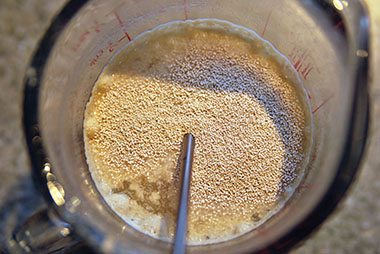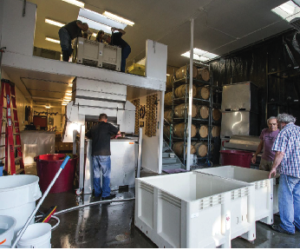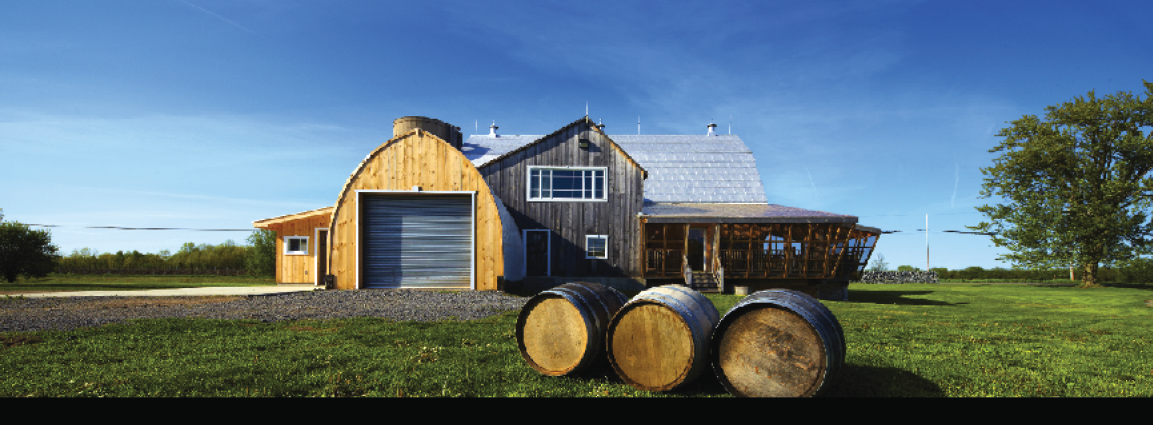 Start with the grapes. Whether you make wine at home from fresh grapes, juice, or frozen must, there are many influences over the quality and character of your wine. Grape variety itself is perhaps most significant for the wine style choices you make. Unless you grow your own grapes — and in some cases, even if you do grow them — other influences may be beyond your control. These include things like the climate of the growing area, the climatic conditions of the particular growing season, and viticultural practices. You may have some influence over other choices such as picking decisions and transport or shipping delays, but ultimately you have the grapes in hand from which you will make your wine.
Start with the grapes. Whether you make wine at home from fresh grapes, juice, or frozen must, there are many influences over the quality and character of your wine. Grape variety itself is perhaps most significant for the wine style choices you make. Unless you grow your own grapes — and in some cases, even if you do grow them — other influences may be beyond your control. These include things like the climate of the growing area, the climatic conditions of the particular growing season, and viticultural practices. You may have some influence over other choices such as picking decisions and transport or shipping delays, but ultimately you have the grapes in hand from which you will make your wine.
When it comes to winemaking decisions, you have much more control. You can decide whether to use enzymes, possible tannin additions, maceration techniques, what yeast to use, and many other decisions are at your fingertips. You may also be able to decide on fermentation temperature, if you have the capability of controlling it in your home winery. Of all these, your decision on yeast strain is one of the most significant that you can make.
That said; how do you make a choice in line with your objectives? After all, unless you are willing to set up side-by-side experiments, you only get one choice per wine per season. You choose it, you rehydrate it, you pitch it — and that’s the wine you get. The challenge is typically not that you have too few choices, but that you have too many. If you look at a chart of yeast recommendations, there are usually several that are recommended for the wine variety you want to make. To help narrow these choices logically and systematically, this article presents a novel decision-making tool — The Yeast Funnel Decision Model — that may help you through the thicket of choices in pursuing the wine of your dreams. For this process, you must imagine a series of four imaginary funnels (as pictured to the right). Entering the first one, the “Variety Funnel,” you have the entire universe of available wine yeast strains. After passing through that funnel, the remaining choices enter the “Grape Constraints Funnel,” where the characteristics of your fruit may narrow your options. After that, imagine your choices entering the “Winery Constraints Funnel,” narrowing your choices further. Finally, pass the remaining yeast options through your own “Style Funnel,” and your decision is practically made.
To get started, decide on the universe of yeast strains from which you will choose. This may be yeasts from a particular manufacturer, those from your favorite online site, or the ones carried by your local home winemaking shop. A good start is to look at a chart of yeast strains that are made available from manufacturers, in winemaking books, and are available on winemaking websites. The yeast chart on WineMaker’s website found here is a good example. This list covers most of the yeast strains that are originally packed by some major producers in small home winemaking packages. Many more yeast strains are available in larger commercial packages. Some retailers such as MoreWine! or The Beverage People repack some of those strains down to home winemaking size. So, if you are interested in exploring more options, look for a longer list to start with. One that I heartily recommend is in Daniel Pambianchi’s Techniques in Home Winemaking (Véhicule Press, 2008). On pages 198-209, Pambianchi explores the range of yeasts factory-packed by the producers for home winemaking, but also goes further to list many more strains produced by Lallemand for commercial production. Similarly extensive information can be gleaned from the websites of Lallemand or other producers like Enartis or Red Star, or in catalogs from retailers who repack yeasts. Whatever list you start with, think of this as your universe of possible wine yeasts. This is the “bin” that you will dump into the first funnel in our decision-making process.
“Variety Funnel”
Consider that the first funnel is the “Variety Funnel.” Look at the charts you have available and make a list of all the yeast strains that are recommended for the variety of grapes you are using. I encourage you at this stage to make it the widest possible list. That is, be very generous in your interpretation of “recommended varieties.” Certainly, include any yeast strain that calls out your variety specifically. For instance, the WineMaker chart lists White Labs French Red as a recommendation for Cabernet Franc. Don’t stop there, though. Consider other varieties that share key characteristics with yours and include those, too. Cabernet Franc is one of the Bordeaux varieties, along with Cabernet Sauvignon, Merlot, Malbec, Petit Verdot, and Carménère. If we broaden our search to include those recommendations, the WineMaker chart gives us eight more choices to toss into the first funnel. Similar groupings that might apply in your case could be the Rhône reds, a selection of aromatic whites, French-American hybrids, or any other family of winegrapes that produce wines of similar character and style. For a rare or unusual variety, you might even consider choices like “dry red wine” or “Italian varieties” to broaden your search further. Don’t worry about having too many choices at this stage — we are going to narrow it down.
Review of key criteria for the “Variety Funnel”:
• Specific grape variety
• Closely related varieties
• Regionally associated varieties
• General wine class
“Grape Constraints Funnel”
Now that you have your list of variety-suitable yeast strains filtered out from the whole universe of available yeasts, it is time to apply two funnels related to constraints: the “Grape Constraints Funnel” and the “Winery Constraints Funnel.” We are applying these filters before getting to style choices due to some basic realities. You can’t make wine that your grapes won’t support and you can’t make wine under conditions you can’t achieve.
Now, consider the grapes. Constraints that might apply would include very high sugar levels that will lead to elevated alcohol levels. If you do not wish to add water and you want your wine to go dry, then you have the constraint that your chosen yeast must be able to survive those high alcohol results. Another constraint from the grapes might include the presence of mold, which suggests a fast start and rapid fermentation to avoid further spoilage. Grapes that were over cropped or from an unusually cool growing season may contribute vegetal character, pointing toward a yeast that may reduce those attributes in the finished wine. Any risk of late sulfuring in the vineyard would suggest avoiding a yeast known to produce hydrogen sulfide during fermentation. Another factor, which also may contribute to the development of hydrogen sulfide, is a lack of nitrogen nutrition in the must. While nutrients can and should be added to help with this problem, it may also be beneficial to select a strain with relatively low nutrient demand if you expect to face this condition. Compare whatever knowledge you have about your grapes with the various comments in your yeast chart to account for as many features as you can.
Review of key criteria for the “Grape Constraints Funnel”:
• High sugar
• Mold, rot
• Vegetal character
• Sulfur use
• Nutrient content
• Other noticeable characteristics of this lot of grapes
“Winery Constraints Funnel”
Next, run your choices through the “Winery Constraints Funnel.” What process variables do you need or want to control for your fermentation? The most immediate constraint of this kind is temperature control. Every yeast chart includes a recommended fermentation temperature for every yeast strain. While we usually prefer cool fermentation for white wines to preserve delicate aromas and warm fermentation for reds for color extraction and ester development, there are limits to both. Go too cool for some wine yeasts and they may just flocculate and drop out without getting the wine to dryness. Go too hot with others and they may suffer from yeast mortality or produce off aromas. Even within the recommended ranges, recognize that trying to ferment near the top or bottom of the temperature range may cause stress in your fermentation and retard a successful outcome. So look at the range, and apply the conditions you have (or can create) in your home winery. If you have a difficult time controlling temperature during fermentation then you should not use a vigorous fermenting yeast that may go too fast. The next major production constraint is time. If you need to complete the fermentation early, for instance to get your fermenters empty in time to make another batch, you may want to look for yeast strains that ferment faster. Finally, there is fermentation capacity. Especially in fermenting white wines in barrels, tanks, or carboys, you must provide adequate headspace to allow for foaming. If this is going to be a challenge for your production, choose a low-foaming yeast.
Review of key criteria for the “Winery Constraints Funnel”:
• Temperature control
• Time requirements
• Fermentation capacity
“Style Funnel”
At this point, you have a selection of yeasts that should be capable of meeting your basic fermentation objectives for a particular lot of grapes. Now you can apply some nuance in terms of the style of wine you wish to make. The final funnel in our series of decision-making is the “Style Funnel.” Within a particular variety, you may have several choices about the kind of wine you want to make. That Cabernet Franc mentioned earlier, for instance, can become a light, fruity quaffing wine or a brooding, dark red wine meant for long cellaring. Having already factored in the grape condition before you got to this point, you may have fewer style choices than you would like. For instance, if those Cabernet Franc grapes are lower in Brix and borderline under-ripe, you may not be able to choose that big red. On the other hand, you may be open to some other choices you didn’t consider earlier, like making a rosé wine instead of a red. You may want a wine to finish bone dry, or you might like a little residual sweetness. You may want a neutral effect on aromas and flavors, or you may want a yeast that releases additional aroma precursors or enhances varietal character. You may be looking for a clean, crisp refresher or you may want to build body and mouthfeel. If you intend to put your wine through malolactic fermentation, it is helpful to choose a yeast strain that does not conflict with the bacterial fermentation. To get an idea of the choices available, you can look at wine type recommendations in the various yeast charts. Pambianchi, for instance, includes terms like tannic red, light young red, sweet white, dry white, intense berry, aromatic white, and so forth. Find the terms that apply to your personal objectives and use them to make the final sort.
Review of key criteria for the “Style Funnel”:
• Sweet or dry
• Neutral
• Enhances varietal character
• Releases aroma precursors
• Contributes mouthfeel, fullness
• Suitable for malolactic fermentation
• Other desired style features
After running your yeast options through this fourth funnel you will probably have no more than two or three choices left. Maybe you are even down to just one yeast strain that has passed through all your funnels and made it to the end. If you have more than one left, put their information side by side and try to imagine the wine you will be enjoying. Does that yeast sound like it will deliver the flavors, aroma, and mouthfeel that you will be looking for? If it got to this point in the selection process, it should be qualified for your wine and you can make a purely artistic selection as the final determinant. If you still have trouble deciding, maybe this is the time for a split batch with some side-by-side comparisons!
Let’s put the Yeast Funnel Decision Model to the test
To bring these theoretical considerations to a more practical level, we will go through a hypothetical example of the Yeast Funnel Decision Model decision process. Let’s make our imaginary Cabernet Franc using Pambianchi’s chart, but restricting it just to prepackaged strains for simplicity. As mentioned above, we are going to use a broad definition, including any mention of other Bordeaux reds.
That gives us this list:
• Lalvin RC 212
• Red Star Pasteur Red
• Red Star Montrachet
• Red Star Pasteur Champagne
• White Labs WLP740 Merlot Red
• White Labs WLP750 French Red
• White Labs WLP760 Cabernet Red
• Wyeast 4028 Chateau Red
• Wyeast 4267 Bordeaux
• Wyeast 4767 Portwine
Now we will apply the “Grape Constraints Funnel.” Here we need to imagine a specific lot of grapes. Let’s suppose we have a fairly high sugar content in our Cabernet Franc at 26 °Brix. If we apply a conversion factor of 0.55, we may get about 14.3% ABV. We want a yeast strain rated to at least 15%. Suppose we also see a little rot in these high-sugar grapes and we want at least a moderate or fast fermentation rate, minimizing risk of spoilage with a slow fermenter. Finally, suppose we intend to pursue malolactic fermentation, which already may be challenging due to the alcohol level, so we want a compatible yeast choice.
Applying these criteria will shorten the list to:
• Red Star Pasteur Red
• Red Star Pasteur Champagne
• White Labs WLP740 Merlot Red
• White Labs WLP760 Cabernet Red
Next we will apply the “Winery Constraints Funnel.” With neither heat nor cooling in the small outbuilding where our winery is located, ambient temperature in the fall will probably keep an indoor space in the range of 70-75 °F (21-24 °C). We will put some Mylar space blankets over the fermenters to try for a little more heat from the fermentation itself, but probably won’t get much past 80 °F (27 °C). There is no time constraint for us this year and fermentation capacity is adequate.
Applying these factors to our remaining yeasts leaves all of them in place:
• Red Star Pasteur Red
• Red Star Pasteur Champagne
• White Labs WLP740 Merlot Red
• White Labs WLP760 Cabernet Red
Finally, it is time to apply the “Style Funnel.” Since this wine is going to be high alcohol in any case, we probably want to go big with it. So we will ferment it using products and techniques that can help make a big, bold, long-aging wine. We want to choose a yeast that supports those objectives as well.
Now our list is reduced to:
• Red Star Pasteur Red
• White Labs WLP760 Cabernet Red
Overall, these strains exhibit quite similar characteristics. One difference is that Red Star Pasteur Red is listed as a fast fermenter, while White Labs WLP760 Cabernet Red is described as moderate. Although we wanted at least “moderate” because of the rot, we also want enough skin contact time to get good tannin extraction for a big red. So, on the narrowest of margins, our artistic decision is to go with the slightly slower fermentation rate and choose White Labs WLP760 Cabernet Red.
Conclusion
There you have it. Starting with a yeast chart that has far too many choices to hold in mind at the same time, we have systematically narrowed it down to the one we want. Equally valuable, we have several finalists and semi-finalists selected, if for some reason we can’t get our first choice in a timely manner.
Speaking of timely, it is smart to do this planning as early as possible in the winemaking season so that you can source the desired strains. You don’t want to be in the position of having chosen a yeast strain only to find out that it is not available to you by the time you need it.
Note that in none of these “funnels” did I include the price of the yeast. The cost of the yeast is usually a small part of the overall effort and expense of home winemaking and is not the best way to decide. Choose your yeast on the basis of the grapes you have and the wine you want and you’ll be a happier winemaker in the end.







